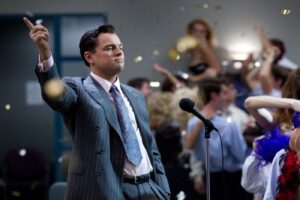Great Characters, But Terrible Role Models: Why We Romanticize Anti-Heroes

A protagonist is often associated with a hero or good guy, but the word simply refers to the point-of-view character. In truth, they vary between spectrums of morality. When you have a protagonist with questionable morals, you get an anti-hero. Despite their actions, these characters are as beloved as the most selfless heroes, sometimes a little too much, and I am not referring to the media panic with Joker (2019) that the film would incite acts of violence (which didn’t happen). A recent rise of people, mainly teen boys and young men on the internet, have been idolizing these characters they refer to as Sigma males, but what is an anti-hero? How do you define a Sigma male character? Why is this important to discuss?
Many protagonists are goody-two-shoes or imperfect people with a heart. Anti-heroes aren’t conventionally good or evil. They play by their own rules and awaken the dark side of our minds that crave some edge. Anti-hero protagonists take stories in places considered taboo to the typical hero’s journey. Satan from John Milton’s Paradise Lost, the biblical embodiment of evil, is cited as fiction’s first anti-hero. He’s still the vengeful dark lord of Hell, but how his eternal torment is expressed compels readers. Some become torn between siding with Satan or God, which I believe was intentional. Milton frames Satan as captivating, yet destructive because that is how he describes evil. “Milton is testing us as readers, attempting to appeal to the good angel on our shoulder over the attractive but ultimately evil devil on the other shoulder,” so says Schmoop. That explains our adoration for the anti-hero archetype, but how did it go from adoration to idolization? A part of it, I’d argue, is related to Sigma culture.

Sigma culture is centered around the aspiration of becoming a Sigma male, a successful lone wolf type of man. Patrick Bateman from American Psycho (2000), a wealthy banker who is also a serial killer, and Jordan Belfort from The Wolf of Wall Street (2013), a rich, successful stockbroker corrupted by wealth and criminal actions, are popular characters associated with Sigma culture. They’re successful, tough, masculine men that teen boys and young men admire and aspire to be. They express it through edits with phonk music and clips of that character on-screen, such as this one. The irony is that the director of American Psycho, Mary Harron, intended Patrick Bateman to be a satirical jab at fragile male egos and our obsession with pursuing wealth, which went over the heads of these men.

The characters featured in these edits are subject to change in accordance with internet trends. The example given here is from 2023, but a new favorite has arisen in Sigma culture, the Superman-parody Homelander from The Boys (2019), which concluded its fourth season this year. Homelander is a psychopathic, egotistical, milk-obsessed blue-eyed Aryan monster who lasers anyone who looks at him funny. As the antagonistic foil to one of the main characters, Billy Butcher (Karl Urban), Homelander has the most focus out of any super-powered character. The previous two seasons of The Boys gave viewers a look into his backstory. Homelander was a lab experiment that never got to have a normal childhood. This got people feeling sympathy for a man who let a bunch of passengers die in a plane crash, among his other atrocities. That is when discussion started to spark on whether Homelander is a villain or an anti-hero. Some like Pauli Poisuo, even go as far as saying he’s a better person than Butcher. How come Homelander sparked this debate? Like Patrick Bateman, Homelander is a wealthy, powerful man, the perfect symbol of American masculinity, but also like Patrick Bateman, he wasn’t meant to be sided with.
The Boys, in general, is a jab at American culture and politics. Many viewers understand the satire, but a vocal minority don’t get the joke.

Sometimes an anti-hero may not fit the same mold as Patrick Bateman or Homelander but still classify as a Sigma male character in the eyes of the internet. The Joker (2019) is the origin story of Arthur, a low-income, aspiring comedian suffering from a mental disorder that causes him to have uncontrollable laughing fits. He performs in a comedy club where he’s ridiculed by everyone, including his idol Murray. In the end, he shoots the same man he idolized. With each kill, Arthur descends further into becoming Batman’s greatest villain. Murray’s death is shocking, but audiences found it satisfying because, like Satan, we’re tempted to root for him off Joaquin Phoenix’s emotional performance and Arthur’s on-screen struggles. Where Patrick Bateman represents the ideal man, Arthur represents the power fantasy of overcoming those in power that bring anger and frustration to their daily lives. With the cost of living increasing and a sequel to the film, Joker: Folie à Deux (2024) coming on October 4th of this year, Joaquin Phoenix’s Joker has only gotten more relevant. Having a movie that makes people feel angry about the state of the world can have a healthy impact, as it sparks demand for change, however within the context of Sigma culture, that anger is misguided and can spiral out of control.
Sigma culture is important to address because it is where forms of toxic masculinity such as violence, bullying, and misogyny thrive. During the late 2010s, an irrational fear arose that the “woke culture” was emasculating men. As a response to this fabricated epidemic, influencers like former kickboxer Andrew Tate used social media platforms to garner views from manipulatable boys who feel unmasculine and listen to his harmful, misogynistic takes. In 2014, Tate once told a Russian kickboxer his girlfriend was “used goods,” hence he should break up with her. When there’s an audience to parrot this and other harmful beliefs of his, it spreads like wildfire, hurting everyone caught in it. Women and minorities are put on the receiving end of their aggression. Men who hear these messages set standards for themselves, leading to lower self-esteem, depression, and in the worst cases, suicide if they can’t accomplish them. Often these men cannot reach those standards in the first place. “Toxic masculinity doesn’t only kill women. It kills men, too. Within those strict ’man rules,’ men can become desperately unhappy and unable to reach out,” specialist psychotherapist Silva Neves said in an article on Psychology Today discussing the harmful effects toxic masculinity has on men and women.


Sigma culture and toxic masculinity also change the way men view media, such as Breaking Bad (2008). Media literacy is the ability to use critical thinking to analyze and evaluate the media we consume, but lately, people’s takes tend to miss the point. It’s ok to have different perspectives on what a piece of media is implying, but sometimes it’s in plain sight and people look in all directions except in front of them. In multiple lists of the most hated TV characters such as this one, Skylar White (Anna Gunn) ranked among the top. So hated in fact, that Anna Gunn reportedly received death threats from a fan. Breaking Bad is about a chemistry teacher who joins the drug game to pay for his lung cancer treatment. Some characters were written to be hated, so we, the audience, can root against them, but Skylar was meant to be the victim of Walter’s involvement with crime. She’s hated for being an obstacle to Walter White’s meth-dealing business, a source of his wealth, pride, and even masculinity.
To perpetrators of toxic masculinity, Skylar is a control freak looking to emasculate Walter. The moment she finds out his money came from selling crystal meth, she becomes hesitant and resentful towards Walter. Skylar White isn’t perfect, she smokes while pregnant, and let’s not forget about the infamous happy birthday scene, but that isn’t comparable to bombing a hospital to get rid of competition. Through his ego, Walter tore apart the relationships he’s built with his family, brother-in-law, and cooking partner Jesse Pinkman (Aaron Paul). He keeps Jesse as his mule-boy through verbal abuse. He gaslights his family into believing he’s in the drug game to support them. In truth, he did it to be seen as the risk-taking breadwinner of his family. The exact man many young boys in Sigma culture wish to be. When you combine poor media literacy with toxic masculinity, you have a section of people unaware that Walter is in the wrong.

We love anti-heroes. They are the little devil on our shoulders tempting us to side with them. We know better, but Sigma culture, the fear of emasculation, and poor media literacy resulted in groups of impressionable, insecure young men romanticizing them. The way we interpret media reveals how we evaluate the world around us. Their hatred towards Skylar White for example may be linked to their pre-established hatred towards women. The media itself is not the cause, but rather the x-ray.

